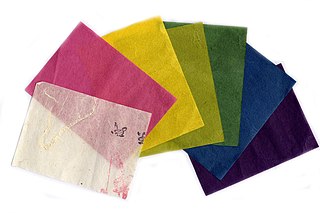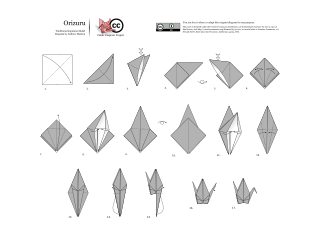 W
WOrigami is the art of paper folding, which is often associated with Japanese culture. In modern usage, the word "origami" is used as an inclusive term for all folding practices, regardless of their culture of origin. The goal is to transform a flat square sheet of paper into a finished sculpture through folding and sculpting techniques. Modern origami practitioners generally discourage the use of cuts, glue, or markings on the paper. Origami folders often use the Japanese word kirigami to refer to designs which use cuts.
 W
WAction origami is origami that can be animated. The original traditional action model is the flapping bird. Models of which the final assembly involves some special action, for instance blowing up a water bomb, are also typically classed as action origami. Rarer models like the paper plane and spinners which have no moving parts are included. Traditional action origami occasionally involved cuts, but modern models typically are constructed without them. Action origami usually are toys built to amuse, but some are designed to inspire wonder.
 W
WBetween the Folds is a 2008 film documentary about origami. Directed by Vanessa Gould and broadcast on Independent Lens, the film received a 2010 Peabody Award.
 W
WChinese paper folding, or zhezhi, is the art of paper folding that originated in medieval China.
 W
WA crease pattern is an origami diagram that consists of all or most of the creases in the final model, rendered into one image. This is useful for diagramming complex and super-complex models, where the model is often not simple enough to diagram efficiently.
 W
WDecorative folding is an artistic type of folding similar to origami but applied to fabrics instead of paper. Some types of objects that can be folded are napkins, towels, and handkerchiefs.
 W
WA fortune teller is a form of origami used in children's games. Parts of the fortune teller are labelled with colors or numbers that serve as options for a player to choose from, and on the inside are eight flaps, each concealing a message. The person operating the fortune teller manipulates the device based on the choices made by the player, and finally one of the hidden messages is revealed. These messages may purport to answer questions or they may be activities that the player must perform.
 W
WThe history of origami followed after the invention of paper and was a result of paper's use in society. Independent paper folding traditions exist in East Asia, and it is unclear whether they evolved separately or had a common source.
 W
WInfinity cube is a kind of mechanical puzzle toy with mathematical principles, the shape is similar to a Rubik's cube. It can be opened and put together from different directions, thus creating a visually interesting effect.
 W
WKirigami (切り紙) is a variation of origami that includes cutting of the paper, rather than solely folding the paper as is the case with origami, but typically does not use glue.
 W
WThe Japanese kusudama is a paper model that is usually created by sewing multiple identical pyramidal units together through their points to form a spherical shape. Alternately the individual components may be glued together. Occasionally, a tassel is attached to the bottom for decoration.
 W
WA masu was originally a square wooden box used to measure rice in Japan during the feudal period. Masu existed in many sizes, typically covering the range from one to to one gō.
 W
WModular origami or unit origami is a paperfolding technique which uses two or more sheets of paper to create a larger and more complex structure than would be possible using single-piece origami techniques. Each individual sheet of paper is folded into a module, or unit, and then modules are assembled into an integrated flat shape or three-dimensional structure, usually by inserting flaps into pockets created by the folding process. These insertions create tension or friction that holds the model together.
 W
WThe orizuru, or paper crane, is a design that is considered to be the most classic of all Japanese origami. In Japanese culture, it is believed that its wings carry souls up to paradise, and it is a representation of the Japanese red-crowned crane, referred to as the "Honourable Lord Crane" in Japanese culture. It is often used as a ceremonial wrapper or restaurant table decoration. A thousand orizuru strung together is called senbazuru (千羽鶴), meaning "thousand cranes", and it is said that if someone folds a thousand cranes, they are granted one wish.
 W
WOrigami paper is used to fold origami, the art of paper folding. The only real requirement of the folding medium is that it must be able to hold a crease, but should ideally also be thinner than regular paper for convenience when multiple folds over the same small paper area are required.
 W
WA paper plane, paper aeroplane (UK), paper airplane (US), paper glider, paper dart or dart is a toy aircraft, usually a glider made out of folded paper or paperboard.
 W
WShide is a zigzag-shaped paper streamer, often seen attached to shimenawa or tamagushi, and used in Shinto rituals. A popular ritual is using a haraegushi, or "lightning wand", named for the zig-zag shide paper that adorns the wand. A similar wand, used by miko for purification and blessing, is the gohei with two shide. A Shinto priest waves the haraegushi over a person, item, or newly bought property, such as a building or a car. The wand is waved at a slow rhythmic pace, but with a little force so that the shide strips make a rustling noise on each pass of the wand. For new properties, a similar ritual known as jijin sai is performed with a haraegushi, an enclosed part of the land, and sake, or ritually purified sake known as o-miki. The haraegushi has been used for centuries in Shinto ceremonies and has similarities in Ainu culture. In Ainu culture, a shaved willow branch called an inaw or inau closely resembles the Shinto haraegushi, and is used in similar blessing rituals.
 W
WThe Sonobe module is one of the many units used to build modular origami. The popularity of Sonobe modular origami models derives from the simplicity of folding the modules, the sturdy and easy assembly, and the flexibility of the system.
 W
WThe Tamatebako (玉手箱) is an origami model named after the tamatebako of Japanese folk tale. It is a modular cube design that can be opened from any side. If more than one face of the model is opened, the cube falls apart and cannot easily be reconstructed. The model, and the directions for creating it, had been lost for centuries and only recently rediscovered.
 W
WOne thousand origami cranes is a group of one thousand origami paper cranes held together by strings. An ancient Japanese legend promises that anyone who folds a thousand origami cranes will be granted a wish by the gods. Some stories believe you are granted happiness and eternal good luck, instead of just one wish, such as long life or recovery from illness or injury. This makes them popular gifts for special friends and family. The crane in Japan is one of the mystical or holy creatures and is said to live for a thousand years: That is why 1000 cranes are made, one for each year. In some stories it is believed that the 1000 cranes must be completed within one year and they must all be made by the person who is to make the wish at the end.
 W
WWashi (和紙) is traditional Japanese paper. The term is used to describe paper that uses local fiber, processed by hand and made in the traditional manner. Washi is made using fibers from the inner bark of the gampi tree, the mitsumata shrub, or the paper mulberry (kōzo) bush. As a Japanese craft, it is registered as a UNESCO intangible cultural heritage.
 W
WWet-folding is an origami technique developed by Akira Yoshizawa that employs water to dampen the paper so that it can be manipulated more easily. This process adds an element of sculpture to origami, which is otherwise purely geometric. Wet-folding is used very often by professional folders for non-geometric origami, such as animals. Wet-folders usually employ thicker paper than what would usually be used for normal origami, to ensure that the paper does not tear.
 W
WThe Yoshizawa–Randlett system is a diagramming system used to describe the folds of origami models. Many origami books begin with a description of basic origami techniques which are used to construct the models. There are also a number of standard bases which are commonly used as a first step in construction. Models are typically classified as requiring low, intermediate or high skill depending on the complexity of the techniques involved in the construction.